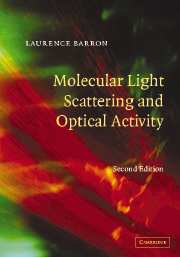Book contents
- Frontmatter
- Contents
- Preface to the first edition
- Preface to the second edition
- List of symbols
- 1 A historical review of optical activity phenomena
- 2 Molecules in electric and magnetic fields
- 3 Molecular scattering of polarized light
- 4 Symmetry and optical activity
- 5 Natural electronic optical activity
- 6 Magnetic electronic optical activity
- 7 Natural vibrational optical activity
- 8 Antisymmetric scattering and magnetic Raman optical activity
- References
- Index
3 - Molecular scattering of polarized light
Published online by Cambridge University Press: 07 August 2009
- Frontmatter
- Contents
- Preface to the first edition
- Preface to the second edition
- List of symbols
- 1 A historical review of optical activity phenomena
- 2 Molecules in electric and magnetic fields
- 3 Molecular scattering of polarized light
- 4 Symmetry and optical activity
- 5 Natural electronic optical activity
- 6 Magnetic electronic optical activity
- 7 Natural vibrational optical activity
- 8 Antisymmetric scattering and magnetic Raman optical activity
- References
- Index
Summary
Edward VII to Lord Rayleigh and Augustine Birrell at a palace party: ‘Well, Lord Rayleigh, discovering something I suppose? You know, he's always at it.’
(Diana Cooper in her autobiography, reporting conversations with Augustine Birrell)Introduction
This chapter constitutes the heart of the book. In it, the theoretical material developed in Chapter 2 is used to calculate explicit expressions, in terms of molecular property tensors, for the polarization and intensity of light scattered into any direction from a collection of molecules. These expressions, which are applied in detail in subsequent chapters, therefore contain the basic equations for all of the optical activity phenomena under discussion.
Polarization phenomena have always been an important part of light scattering studies. For example, Tyndall's early investigations with aerosols (1869) showed that linear polarization was an important feature of light scattered at right angles, and he pointed out that (quoted by Kerker, 1969) ‘The blue colour of the sky, and the polarization of skylight … constitute, in the opinion of our most eminent authorities, the two great standing enigmas of meteorology.’ This enigma was resolved by Lord Rayleigh (1871) who showed that the intensity of light scattered by a uniform sphere much smaller than the wavelength is proportional to 1/λ4, the component scattered at right angles being completely linearly polarized perpendicular to the scattering plane, indicating that the colour and polarization of skylight originates in the scattering of sunlight by air molecules.
- Type
- Chapter
- Information
- Molecular Light Scattering and Optical Activity , pp. 123 - 169Publisher: Cambridge University PressPrint publication year: 2004
- 2
- Cited by

